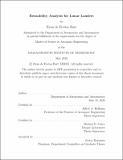| dc.contributor.advisor | Jeffrey A. Hoffman and Michael D. Curry. | en_US |
| dc.contributor.author | De Freitas Bart, Ryan. | en_US |
| dc.contributor.other | Massachusetts Institute of Technology. Department of Aeronautics and Astronautics. | en_US |
| dc.date.accessioned | 2020-11-24T17:32:01Z | |
| dc.date.available | 2020-11-24T17:32:01Z | |
| dc.date.copyright | 2020 | en_US |
| dc.date.issued | 2020 | en_US |
| dc.identifier.uri | https://hdl.handle.net/1721.1/128629 | |
| dc.description | Thesis: S.M., Massachusetts Institute of Technology, Department of Aeronautics and Astronautics, May, 2020 | en_US |
| dc.description | Cataloged from student-submitted PDF of thesis. | en_US |
| dc.description | Includes bibliographical references (pages 87-91). | en_US |
| dc.description.abstract | As the world prepares to return to the lunar surface with the Artemis program, NASA recommended developing a reusable lunar lander to enable a sustainable exploration program. It is logical to think that reusing a lunar lander instead of building a new one for each mission is more cost-effective, but this statement only holds for some mission architectures. This work explores the principal effects of adding reusability and quantifying its impact on manned lunar lander designs. A multidisciplinary model is presented that explores the lunar lander design space to understand how reusability impacts the chosen objectives of IMLEO, life-cycle cost, and safety. The choice of reusability and the use of a cislunar space station are found to have the greatest impact on the chosen objectives. The effect of changing the refurbishment cost per mission is also analyzed. An optimization framework is then applied to the resulting model to determine the optimal lunar lander design for a given mission. For the Artemis program, an expendable design was found to be more cost-effective than implementing reusability as only five lunar surface missions are currently planned. However, if additional missions are added a hybrid implementation of reusability, which entails reusing the transfer and ascent elements multiple times but changing out line-replacement units after each mission, becomes most cost-effective. Furthermore, a fully reusable design, where the transfer and ascent elements only require consumables to be replenished between missions, was found to be less cost-effective than a hybrid design for the range of values studied. The results of this work are intended to guide the development of the next generation of lunar landers and future space systems as the model and optimization framework can be adapted to explore the benefit of reusability for a wide range of space systems. | en_US |
| dc.description.statementofresponsibility | by Ryan de Freitas Bart. | en_US |
| dc.format.extent | 91 pages | en_US |
| dc.language.iso | eng | en_US |
| dc.publisher | Massachusetts Institute of Technology | en_US |
| dc.rights | MIT theses may be protected by copyright. Please reuse MIT thesis content according to the MIT Libraries Permissions Policy, which is available through the URL provided. | en_US |
| dc.rights.uri | http://dspace.mit.edu/handle/1721.1/7582 | en_US |
| dc.subject | Aeronautics and Astronautics. | en_US |
| dc.title | Reusability analysis for Lunar Landers | en_US |
| dc.type | Thesis | en_US |
| dc.description.degree | S.M. | en_US |
| dc.contributor.department | Massachusetts Institute of Technology. Department of Aeronautics and Astronautics | en_US |
| dc.identifier.oclc | 1204663486 | en_US |
| dc.description.collection | S.M. Massachusetts Institute of Technology, Department of Aeronautics and Astronautics | en_US |
| dspace.imported | 2020-11-24T17:32:00Z | en_US |
| mit.thesis.degree | Master | en_US |
| mit.thesis.department | Aero | en_US |
